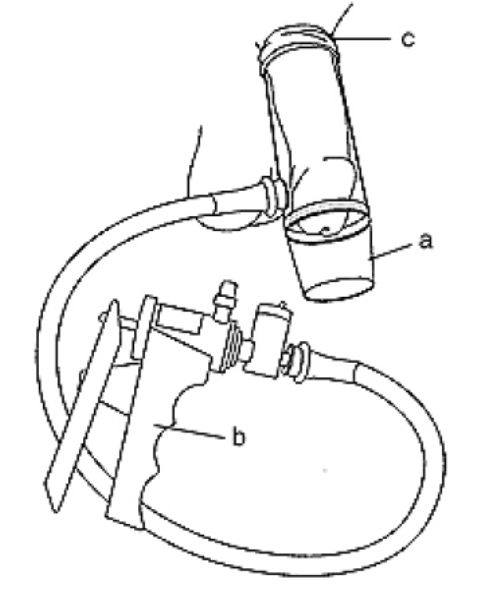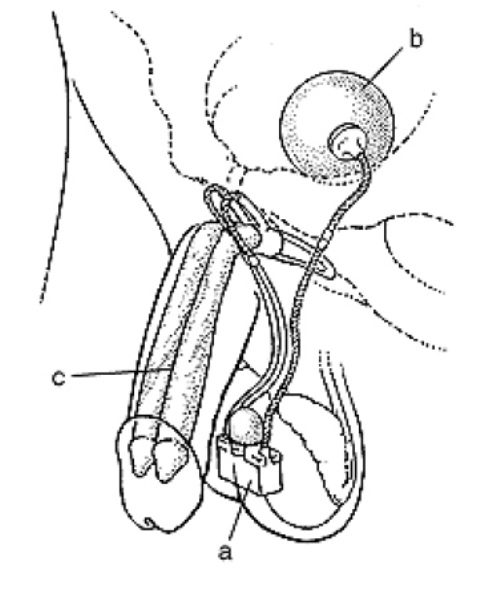Most physicians suggest that treatments for impotence proceed along a path moving from least invasive to most invasive. This means cutting back on any harmful drugs is considered first. Psychotherapy and behavior modifications are considered next, followed by vacuum devices, oral drugs, locally injected drugs, and surgically implanted devices (and, in rare cases, surgery involving veins or arteries).
Psychotherapy
Experts often treat psychologically based impotence using techniques that decrease anxiety associated with intercourse. The patient’s partner can help apply the techniques, which include gradual development of intimacy and stimulation. Such techniques also can help relieve anxiety when physical impotence is being treated.
Drug Therapy
Drugs for treating impotence can be taken orally, injected directly into the penis, or inserted into the urethra at the tip of the penis. In March 1998, the Food and Drug Administration approved sildenafil citrate (marketed as Viagra), the first oral pill to treat impotence. Taken 1 hour before sexual activity, sildenafil works by enhancing the effects of nitric oxide, a chemical that relaxes smooth muscles in the penis during sexual stimulation, allowing increased blood flow. While sildenafil improves the response to sexual stimulation, it does not trigger an automatic erection as injection drugs do. The recommended dose is 50 mg, and the physician may adjust this dose to 100 mg or 25 mg, depending on the needs of the patient. The drug should not be used more than once a day.
Oral testosterone can reduce impotence in some men with low levels of natural testosterone. Patients also have claimed effectiveness of other oral drugs–including yohimbine hydrochloride, dopamine and serotonin agonists, and trazodone–but no scientific studies have proved the effectiveness of these drugs in relieving impotence. Some observed improvements following their use may be examples of the placebo effect, that is, a change that results simply from the patient’s believing that an improvement will occur.
Many men gain potency by injecting drugs into the penis, causing it to become engorged with blood. Drugs such as papaverine hydrochloride, phentolamine, and alprostadil (marked as Caverject) widen blood vessels.
These drugs may create unwanted side effects, however, including persistent erection (known as priapism) and scarring. Nitroglycerin, a muscle relaxant, sometimes can enhance erection when rubbed on the surface of the penis.
A system for inserting a pellet of alprostadil into the urethra is marketed as MUSE. The system uses a pre-filled applicator to deliver the pellet about an inch deep into the urethra at the tip of the penis. An erection will begin within 8 to 10 minutes and may last 30 to 60 minutes.
The most common side effects of the preparation are:
- aching in the penis, testicles, and area between the penis and rectum;
- warmth or burning sensation in the urethra;
- redness of the penis due to increased blood flow;
- minor urethral bleeding or spotting.
Research on drugs for treating impotence is expanding rapidly. Patients should ask their doctors about the latest advances.
Vacuum Devices
Mechanical vacuum devices cause erection by creating a partial vacuum around the penis, which draws blood into the penis, engorging it and expanding it. The devices have three components: a plastic cylinder, in which the penis is placed; a pump, which draws air out of the cylinder; and an elastic band, which is placed around the base of the penis, to maintain the erection after the cylinder is removed and during intercourse by preventing blood from flowing back into the body (see figure).
One variation of the vacuum device involves a semirigid rubber sheath that is placed on the penis and remains there after attaining erection and during intercourse.
Surgery
Surgery usually has one of three goals:
- To implant a device that can cause the penis to become erect,
- To reconstruct arteries to increase flow of blood to the penis,
- To block off veins that allow blood to leak from the penile tissues.
Implanted devices, known as prostheses, can restore erection in many men with impotence. Possible problems with implants include mechanical breakdown and infection. Mechanical problems have diminished in recent years because of technological advances.
Malleable implants usually consist of paired rods, which are inserted surgically into the corpora cavernosa, the twin chambers running the length of the penis. The user manually adjusts the position of the penis and, therefore, the rods. Adjustment does not affect the width or length of the penis.
Inflatable implants consist of paired cylinders, which are surgically inserted inside the penis and can be expanded using pressurized fluid (see figure). Tubes connect the cylinders to a fluid reservoir and pump, which also are surgically implanted. The patient inflates the cylinders by pressing on the small pump, located under the skin in the scrotum. Inflatable implants can expand the length and width of the penis somewhat. They also leave the penis in a more natural state when not inflated.
With an inliatable implant, erection Is produced by squeezing a small pump (a) implanted in the scrotum. The pump causes fluid to flow Irom a reservoir (b) residing in Ihe lower pelvis to two cylinders (c) residing in the penis. The cylinders expand to create ihe erection.
Surgery to repair arteries can reduce impotence caused by obstructions that block the flow of blood to the penis. The best candidates for such surgery are young men with discrete blockage of an artery because of an injury to the crotch area or fracture of the pelvis. The procedure is less successful in older men with widespread blockage.
Surgery to veins that allow blood to leave the penis usually involves an opposite procedure–intentional blockage. Blocking off veins (ligation) can reduce the leakage of blood that diminishes rigidity of the penis during erection. However, experts have raised questions about this procedure’s long-term effectiveness.

